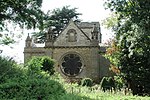Cosgrove aqueduct

Cosgrove aqueduct is a navigable cast iron trough navigable aqueduct that carries the Grand Union Canal over the River Great Ouse, on the borders between Buckinghamshire and Northamptonshire at the northwest margin of Milton Keynes in England. The present structure was built in 1811, to replace a previous brick structure that had failed. When the present structure was erected, it was known as the "Iron Trunk". The structure has two cast iron trough spans, with a single central masonry pier. The abutments were constructed in masonry but have been refaced in brick during the twentieth century. The trough is 15 feet (4.6 m) wide, 6 ft 6 in (1.98 m) deep, with a total length of 101 feet (31 m). The canal surface is about 40 feet (12 m) above the surface of the river. There are large approach earthworks about 36 feet (11 m) high above the valley floor and 150 feet (46 m) wide, with a total length of half a mile (800m).
Excerpt from the Wikipedia article Cosgrove aqueduct (License: CC BY-SA 3.0, Authors, Images).Cosgrove aqueduct
Stratford Road, Milton Keynes Wolverton Mill
Geographical coordinates (GPS) Address External links Nearby Places Show on map
Geographical coordinates (GPS)
| Latitude | Longitude |
|---|---|
| N 52.0687 ° | E -0.8336 ° |
Address
Iron Trunk Aqueduct
Stratford Road
MK12 5NX Milton Keynes, Wolverton Mill
England, United Kingdom
Open on Google Maps









